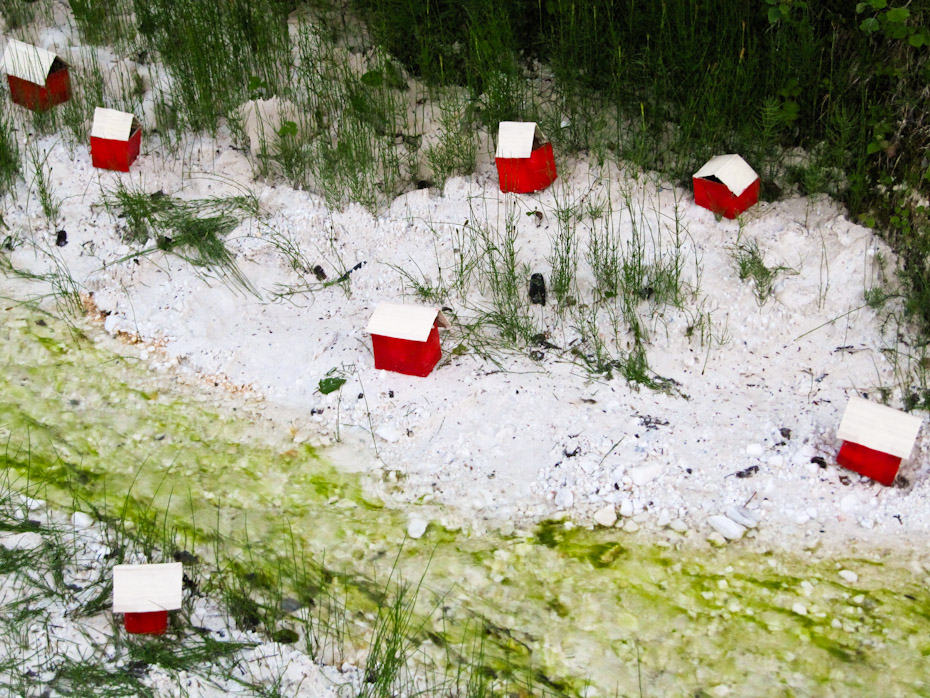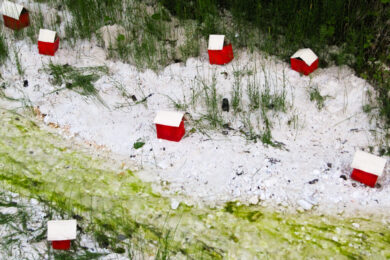In the hills overlooking the tiny North Norwegian town of Fauske, an hour’s drive west of the forgotten city of Bodø, two figures stand silhouetted against the cliffs. Guitars slung over their shoulders, they throw their voices into mysterious caves whose floors are buried beneath half a metre of luminescent malachite water which soaks up the quiet echoes reverberating briefly back at us. Sondre Justad and Marte Røyeng, who look no older than 20, are here to perform in a couple of days’ time at Ut Av Vår Hule (Out Of Our Caves), a boutique festival so small it makes Latitude look like Woodstock. They’ve never played together before: Sondre’s regular band, Giraff, were booked, but some of the members can’t make it and so he’s invited Marte to take their place. They don’t yet know what they’re going to do: another friend, Runar Nybø, is on his way, so they’ll simply sit down after some dinner and see where things lead.
"Are you worried?" I ask.
"I think we’ll be inspired," Sondre grins shyly, his face pink beneath his striking blonde hair. Marte, a round-faced girl whose eyes smile even when there’s no reason to be amused, nods in quiet agreement beside him.
Their response isn’t a display of arrogance or naïve confidence. It’s dictated by our surroundings, and all I can do is agree. The ground underneath is brilliant white, the cliffs around us matching, and to our right a giant dune reaches up to the horizon like a small-scale snowy mountain. But this is mid July, months after the snow has melted on all but the highest peaks. We’re standing in the middle of one of Fauske’s marble mines, and the caves that extend far into the hillside are evidence of the excavations that have provided ‘Norwegian Rose’ to places like the UN Building and the Japanese Emperor’s Palace. To our left, a small quarry filled with aquamarine water dares us to leap in and swim amidst the vast, smooth rocks whose peaks poke out like icebergs. And, just out of sight, lining the pale track that reaches back to the road, vast derelict buildings cast shadows over the marble grit spilled over decades of mining. Their windows are broken, their paint peeling, their insides musty and grey. It’s towards these that we stroll, and while we do so more figures appear, like animals emerging from their burrows at night. As Sondre and Marte run through a few ideas seated on dusty rocks beneath the light of a shattered window, artists with hands coloured a curious pale yellow by the rocks stroll purposefully towards different corners of the grounds, while another ties together long twigs with tape and binders in the shape of, she explains, a large dinosaur egg. A nearby puddle is streaked red with paint, and green signs decorated with the festival’s name dry in the sun against rusty barrels and abandoned machinery.
Ut Av Vår Hule is actually an art festival, the idea of three Norwegian women, Jenny Vangen, Rakel Nystabakk and Sara Bruteig Olsen. Recognising the potential of this remarkable environment, they gathered together artists to exploit the landscape, adding two stages – a main one that allows the audience to stare into the caves in contemplation or awe, and a smaller in the biggest of the dilapidated buildings – to showcase young and emerging talent. There are no big names here, though some from the first year’s event back in 2008 – the festival is intended to be every two years – have gone on to make waves nationally and, in the case of Moddi, beyond the country’s borders. Instead these are artists and musicians drawn by the opportunity of engaging with their surroundings: no one is paid, something which Jenny points out ensures that anyone taking part is committed for artistic rather than financial reasons.
Two days later, by the time the festival has opened, the grounds have been decorated with understated, surreally witty installations that highlight the lack of imagination employed by the majority of festivals eager to prove they’re more than your standard event-in-a-muddy-field. Tracing a path up the marble mountain are a series of black doors leading to another that stands proudly atop. A spray-painted series of green half-tyres snakes its way out of one of the caves. Yellow and silver plastic ducks nestle at the edge of the stream making its way along the path to the stage, with miniature houses perched amidst the algae like cottages in Alpine meadows. A giant beach umbrella provides shade at a small table on a plateau in the hillside, while the wreckage of one of the machine buildings has been furnished like a grandmother’s home.
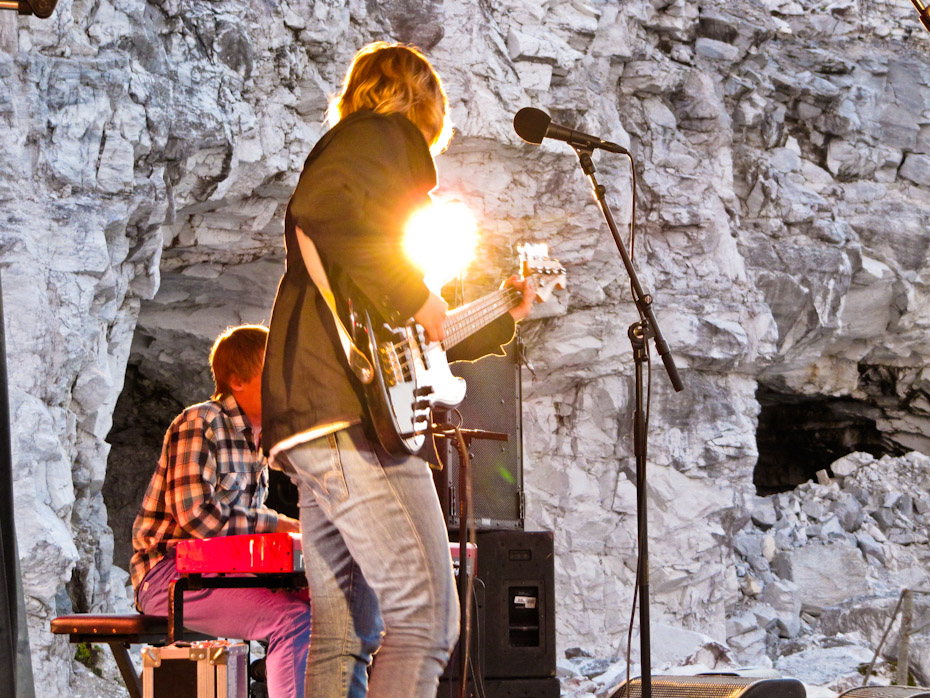
Sondre Justad and Marte Røyeng thaw out punters’ hearts…
I’m not supposed to be here. I’m supposed to be on holiday in a fjord-side cabin some ten minutes drive away and then twenty minutes walk through the woods. It was only a chance encounter in the local supermarket between the friend who’s joined me and an old acquaintance from Svalbard, Norway’s northernmost region, that enlightened us as to the existence of the mine in the first place, and it’s pure luck that our visit coincided with Sondre and Marte’s search for inspiration. But the moment we arrive to hear the Brian Eno / David Byrne-meets-Tortoise warped dub of 2 x Slagwerk – aka Øyvind Skarbø and Hans Olav Molde – booming from the outdoor stage, I know we’ve made a good decision. These two drummers bash out contrapuntal rhythms over samples and electronic soundscapes on a stage lit only by red and white lights, its roof extended at the front to protect performers from the midnight sun, while a small but dedicated crowd sways and twists in time, applauding each tune with enthusiastic whoops. It’s odd to find myself jerking occasionally out of the trance the band’s induced to emerge into this white frozen tundra, shivering instinctively, only to realise that it’s still warm. My eyes are lying to a brain lost in music. 2 x Slagwerk remain in their own world, however, throwing in hints of Eastern European folk and then finishing with a breakbeat number that provokes outbreaks of affectionately ironic bodypopping and cutely accented cries – in English, curiously – of "We want more!"
Beneath the white awning of the bar, its legs propped on rocks to compensate for the uneven ground, I talk to some of the people involved. It took a long time to get the festival approved, I learn, because of the mine’s potential for mishap, but eventually they got the go-ahead, seeking grants from arts organisations to fund the first event. The caves aren’t strictly marble, I’m also disappointed to discover, but dolomite, though a discussion then breaks out as to whether dolomite qualifies as marble. In the lull that follows, my friend introduces me to a quietly spoken makeup artist called Magne Mattsson, who explains how he performed the first year dressed in workers’ clothes that he then slowly removed to reveal he was dressed as a woman.
"Are you planning to repeat that?" I enquire.
"This time I’m going to sing songs about death," he replies, explaining briefly about his cabaret Døden Kler Meg (Death Becomes Me). "I don’t know if I’ll dress as a woman again. I have to feel the urge to do that. But I did see a nice dress at the fleamarket…"
He joins me down the front to watch Sondre, Marte and Runar. They appear nervous, Marte’s voice initially like a panic-stricken Beth Orton, but she gains confidence swiftly when Sondre sings alongside her, simultaneously hammering the keys of his electric piano. I’m hoping they’ll be good: I’ve warmed to the three of them fast, and I’m not disappointed. They shift and share vocal duties, while Marte moves between guitar, bass and mandolin and Runar between bass and drums. Their classicist pop breaks no new ground, but there’s a youthful conviction to their performance, no previous disappointments dragging them down. Their set is uplifting, intimate and innocent, and beside me Magne grins enthusiastically. They close with a sensitive ballad, Sondre’s voice genuinely choked by its sentiment. "I can’t leave without letting you know," he pleads, teasing out a gorgeous melody, and, though the content is standard breakup material, its context – the white rocks framing the stage like frost – transforms the song, revealing its soul much in the way an unexpected song on an iPod shuffle can shed new light on one’s surroundings. In fact I’m struck by just how perfect it is to hear this song right here, right now, as a guest singer adds a third layer of choral harmonies and Sondre repeats, desperately, the simple refrain: "I need your love". They grin as they leave the stage and head to the bar. They know they’ve been inspired.
It’s way past midnight now, and at last the sun has dipped beneath the horizon, the temperature dropping swiftly so that the artificial Arctic landscape around us finally starts to feel real. There’s only one more band, Fipp, and the appearance on stage of a Hawaiian shirted individual carrying a French horn does little to inspire confidence. But it takes only a moment to realise these are rock critic prejudices that are of no relevance here. In fact the instrument adds a unique texture and an extra euphoric dimension to their furiously complex instrumental workouts, and in fact Fipp turn out to be an extraordinary find. Coming on initially like Trans Am playing early Mogwai, they break out into squalls of thrash, tight as the chuffs on the mosquitoes that divebomb us, then shift into what sounds like Lalo Schiffrin’s Dirty Harry soundtrack after an especially bad acid trip. At one stage the drummer hits his kit so hard that the ride cymbal falls off his riser and the band are forced to pause while a member of the audience runs up to fix it. Finally, after a feast of time changes and virtuoso playing, I locate their almost Wagnerian sound somewhere between Jaga Jazzist and The Shining. I intend to return there.
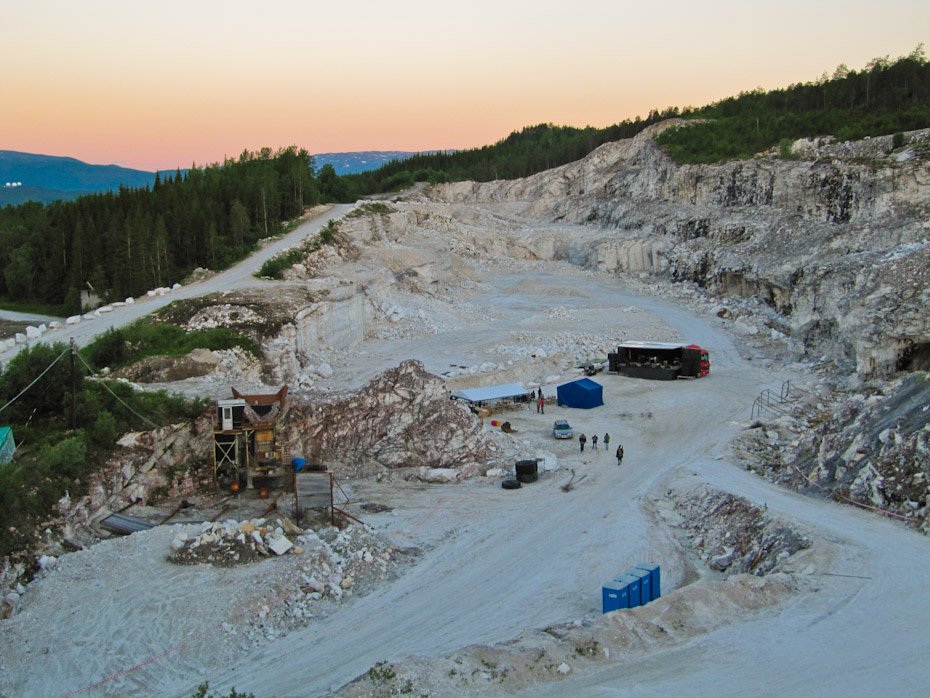
The festival area at dawn.
As they finish, organiser Sara takes the microphone to inform everyone that the bar will be closing in ten minutes and that there’s a DJ down the hill in one of the wrecked buildings. My companion and I decide to skip the dancing, however, in favour of ascending the mountain built from discarded dolomite marble chippings and grit. Shielded from the wind by rugs we’ve borrowed from one of the bars, we sit at its peak and wait for the sun to rise over the hilltop. Beside us a lone door stands like an entrance into a parallel world that we can already see. Beneath us we can make out the last of the revellers congregating around the main building, distant strains of music leaking from its windows.
"What a place," I murmur.
My companion nods and mutters something about how special it is to be amidst nature.
"Big hippy," I chuckle, but then it strikes me that we’re not really amidst nature at all. This is nature wrecked by man, reclaimed by nature but then embraced by man, a far more complex and indeed realistic reflection of the myriad ways we can find beauty. There’s no showiness: no one is trying to draw attention to the landscape in that desperately suburban style beloved of so-called boutique festivals designed to prove how in touch with the land they really are; no one is making highfalutin claims for the art, which sits discreetly around us as it elaborates on the alien landscape, or for the music, which is performed with the minimum of fuss and the maximum of joy. No one is drunkenly challenging others to take a refreshing dip in the ‘natural’ pool, or to yodel into the caves. There are no barriers, neither between the public and what some might deem hazardous locations, nor between the people attending and the musicians, who run down after their sets to hang out with beers and friends while a car pulls up to the front of the stage and loads in their amplifiers. There are no police in evidence, testing the audience and doubting its sense of responsibility, and the only scuffle is a typically good-natured Norwegian play fight. There is, instead, music and art united by the very thing that inspires them: nature and humanity. There’s that and a revitalised joy of discovery: of new music, new environments, new friends and the old-fashioned virtues of trust, freethinking and mutual respect, the original reasons people once gathered for festivals.
As the golden glow of the sun starts to bleed over the mountaintop, warming our faces, lighting up the mist in the valleys, we raise our beers and toast new horizons. Then we pull ourselves to our feet, skip childishly down the marble grit hillside, and return our plastic cups to the bar. In the makeshift dormitory in the cabin next door to the tent the organisers have kindly lent us, Sondre, Marte and Runar rest contentedly, exhausted from their youthful celebrations and post-show adrenalin. We throw down more rugs beneath the canvas and tuck our sweaters under our heads. Although I hate camping, I fall asleep in seconds. Overhead, the Arctic sun bakes the tent. It’s winter in July, and everything is as it should be.
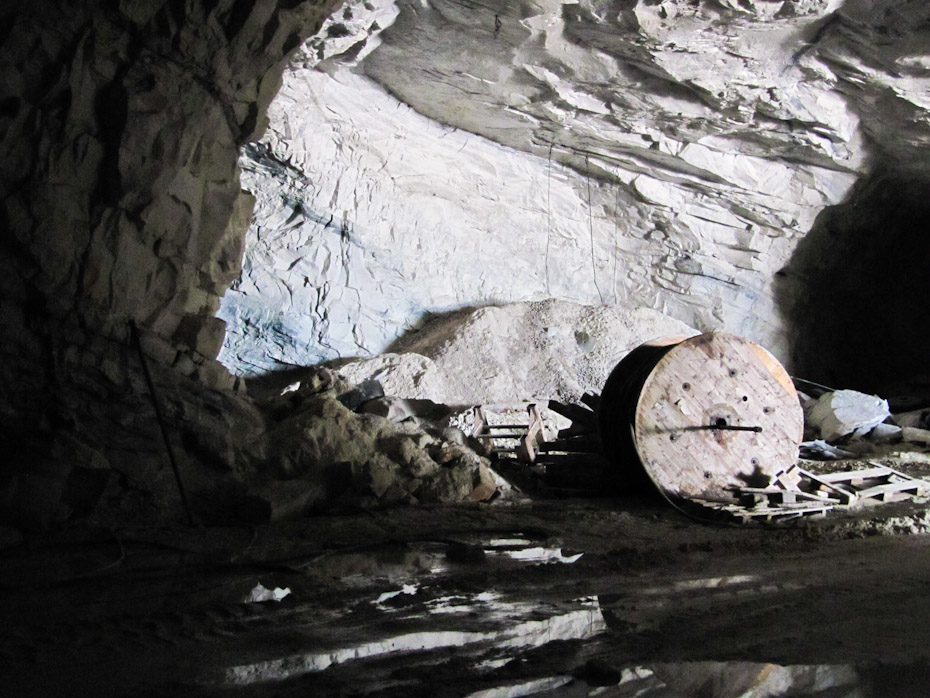
Behind the scenes at Ut Av Vår Hule

